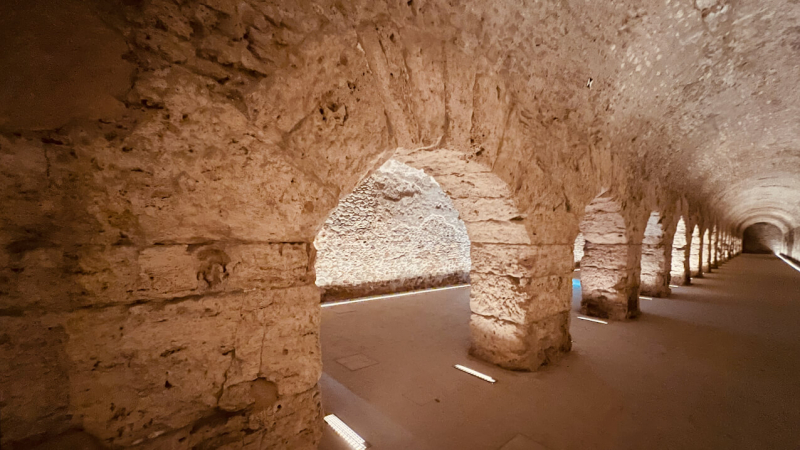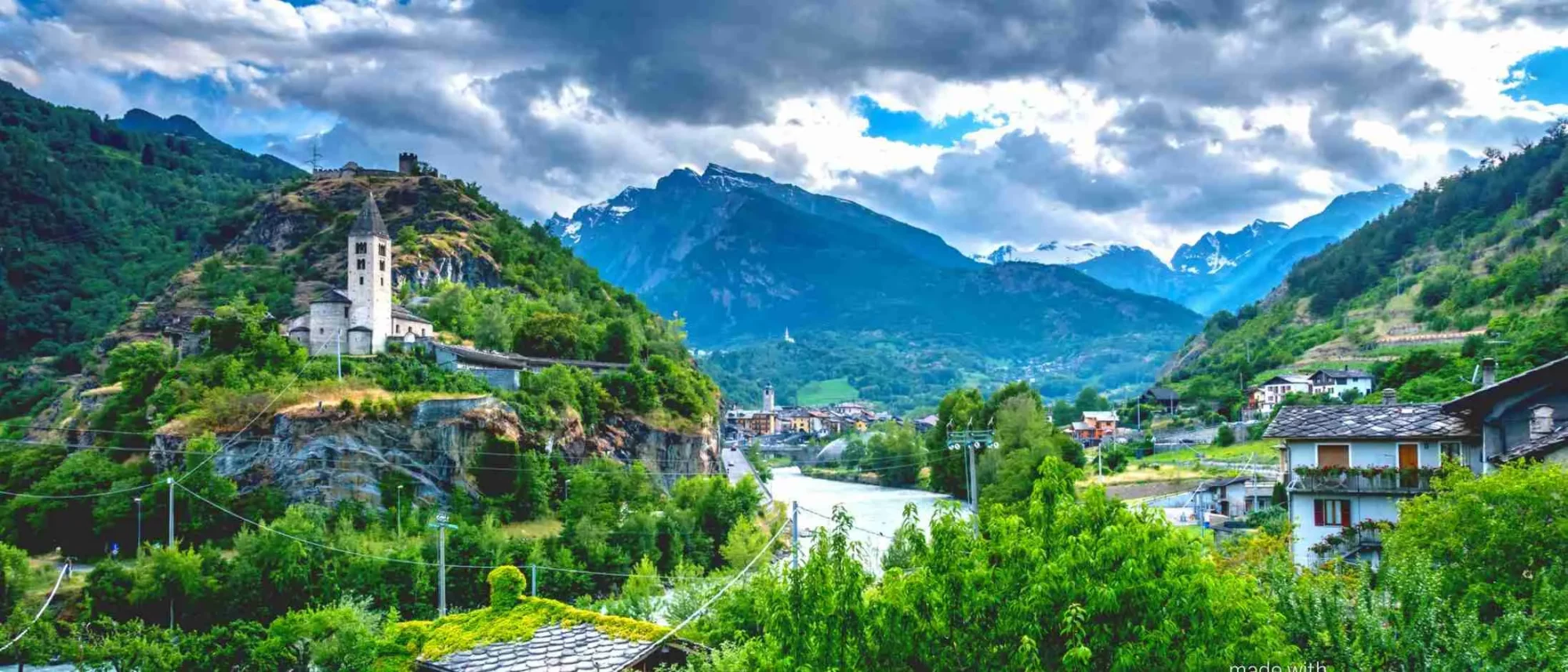
The enigmatic cryptoporticus
Buon giorno, good people! I’m back with what has turned out to be not-quite-the-final instalment from the Aosta Valley, Italy’s biggest secret.
Now, if you remember, the last episode had quite a bit of hiking in it. But not everyone is into all that physical exertion. Perhaps your partner or travel mates are massively into sports and you, not so much? Fear not. It’s time for more cultural experiences in the valley. Today, we’ll have a look at Aosta, capital of the autonomous, bilingual region Valle d’Aosta. This small, walled city sits in the shadow of mighty Monte Bianco/Mont Blanc, 110 km from Turin, near the Italian end of the Mont Blanc Tunnel. Three countries converge nearby: France is ca. 30 minutes north-west, and Switzerland ca. 45 minutes north.
Augusta Praetoria Salassorum: Roman Aosta
Aosta dubs itself Northern Rome. Ancient Rome, that is. And as can be expected with such a moniker, there’s plenty of history, and archaeological remains. The rivers Buthier and Dora Baltea meet here in Aosta, thus making the city an important military location through the ages. Reason enough, I’m sure, for Emperor Augustus to found a colony here back in 25BCE. He named it Augusta Praetoria Salassorum. The last part of the name refers to the Gallic tribe living here before Augustus and his Praetorians conquered them.
The Roman ruins in Aosta are extensive and very well preserved: the Criptoportico forense (forum cryptoporticus), a large city gate, a bridge, a theatre, an amphitheatre and the Arch of Augustus.
Hold on, you say. Back up a bit! Forum cryptoporticus? What is this cryptoporticus?
The forum cryptoporticus
I’m glad you asked. In fact, let’s begin with the cryptoporticus. An intriguing word, isn’t it?

A cryptoporticus is a covered passageway. The one here in Aosta dates back to Augustus’ day, and comprises an underground gallery, with two naves separated by arches. Windows provide light and airflow for relatively constant temperatures.
The purpose of this cryptoporticus is not known. A warehouse, perhaps? Or some sort of military structure? A place connected to the rich and politically powerful of the time? Or even a religious structure, like a temple?
It feels kinda secret down here. The extra lighting makes wandering through rather thrilling, inspiring wild imaginings. I can easily see this as a setting for a spooky scene in a crime story. I wonder… would I set it in medieval times – or today? Or perhaps both, switching back and forth?
Porta Praetoria, Roman bridge and Arch of Augustus

Porta Praetoria was the eastern access to the Roman colony. A large arch in the middle, as you can see, creating easy through access for horse-drawn carriages. On either side, two smaller ones for folks on foot. At either side is a defensive tower.
A mighty 6-metre wide Roman stone bridge crosses the Buthier River. Or crossed, rather. The water is no longer underneath the bridge, as the little river changed directions during medieval times. The bridge leads to Arco de Augusto de Aosta, the Arch of Augustus, a monument celebrating Augustus’ victory over the aforementioned Salassi.
Teatro romano
The 22-metre high south facade you see here is what remains of Aosta’s Roman theatre, built late in Augustus’ era.

Today, it is used for concerts and theatre productions, and light shows on summer nights.


Room for 3 – 4000 spectators here back in the (Roman) day. Also, notice the spectacular alpine background!
Aosta Cathedral
But Aosta is not all about Ancient Rome. Let’s move on about four centuries, when work on Aosta’s cathedral began. Hopping forward to the Renaissance, and Cattedrala Santa Maria Assunta gets its present-day structure. Finally, in the 1800s, a Neo-classical twist was added.


Fascinating facade: Renaissance in a neo-classical frame
Do step inside; it is quite beautiful – and Gothic!


Saint Ursus complex

Onwards a further 500 years, and we have the Collegiata di Sant’Orso, the Collegiate Church of Saint Ursus, with the attached monastery, still in operation. The complex is dedicated to Saint Ursus, a 6th century priest of Irish origin, so the story goes. When an Arian bishop took over the cathedral here in Aosta, Ursus left in protest. Arianism, if you’re not familiar (I wasn’t), is the belief that Jesus – as opposed to God – is not eternal. Since he is God’s son, he is subordinate to his father. Hm… apparently, details are important.
As for the church, it is quite simple. I rather like that. Not furnished with gold and riches robbed from Latin America and elsewhere. There is also a lovely wooden choir.


A touch of Hogwarts?
The most interesting part here, though, is the monastery and the surrounding courtyard.


Darkened by time and ancient varnish, the marble capitals (and no, we are not talking letters – or stocks, but in the architectural sense, i.e. the topmost part of a column), are decorated with fantastic beasts, biblical events and scenes from the life of Saint Ursus himself.

Capital(s)

Hôtel de Ville and the historic city centre
On the elegant Piazza Émile Chanoux, you will see the Neo-classical Hôtel de Ville, City Hall, with two fountains on the facade, representing Aosta’s two rivers, Dora Baltea and Buthier. Inside the airy arcades here, you might want to stop for coffee at the 200-year-old Caffè Nazionale.
The piazza is surrounded with bars and restaurants, and has an annual Christmas market, sure to be atmospheric.

(I should point out that the Hôtel de Ville is a large, rectangular building, not rounded as it appears here. I used the panorama function to get it all in one shot.)
The piazza’s namesake, Émile Chanoux, in case you wondered (as I did), was a politician and resistance fighter; arrested, tortured and murdered by the SS in 1944.


The city centre is pedestrianised and very walkable with cosy cafes and shops along charming squares and streets. Don’t miss the ruelles, the little alleys that weave through town.
Aymavilles Castle
Remember I mentioned the cool Castel Savoia in the last post? Well, that’s not the only castle around. For such a small region, the Aosta Valley is practically overflowing.

A 13-minute drive from Aosta, at the entrance to Cogne Valley, is Castello d’Aymavilles; tall and graceful, rising above the valley. Originally built in the 12th century, it has been substantially altered over the centuries and now appears Baroque.
Now, it may have been that fantastic staircase. Or the story of fab Queen Margherita of pizza fame. Whatever the reason, of the two castles, I prefer Savoia. That said, Castello d’Aymavilles is a worthwhile stop en route to Cogne.

Vinosteria Antirouille
A fun place to stop for lunch – or for sipping a glass of wine or a local draft beer – is Vinosteria Antirouille (meaning ‘Wine Bar Anti Rust’), a 2-minute drive (or ca 15-minute walk) away from the castle.
In this post, I mention cured ham and cheeses seemingly being the antipasto of choice in the Aosta Valley. Well, here at the vinosteria, they take it to the next level; meat and cheese boards are sold by length. How does a 2-metre ham and cheese-board strike you? Too much? At the other end of the scale is a little 1/4-metre one.

There’s seven of us, so 1.5 metres of cured goodness in a pleasant garden is just about the right antipasto.
OK, this was originally going to be the final chapter in the Aosta Valley chronicles here on Sophie’s World, but I decided to split it in two. Next – and last – up, is Cogne Valley, a lovely family-run eco hotel, and the Gran Paradiso (fab name, isn’t it? Not just Paradiso, but Gran Paradiso!) Watch this space.
